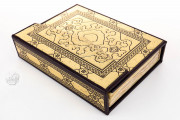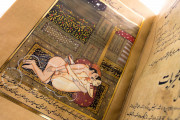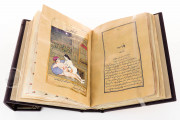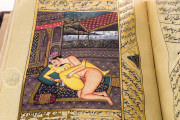Kama Sutra literally means "Treatise on sexual pleasures". In the fourth century, the Hindus discovered the Kama Sutra: the cultivation of sexual pleasure, independent of procreation, which was considered one of the highest pleasures of life. The ancient Hindus believed that life had three purposes: religious piety (Dharma), material success (Artha), and sexual pleasure (Kama).
These three aims are equal, and the erotic mysticism is based on the beauty. In the Hindu world, the pursuit of sexual pleasure was revered as a kind of religious quest. In a nutshell, the art of making love.
The Persian Kama Sutra MS 17 from the Collection Miguel Huguetvinas is a codex which contains 119 miniatures through various origins: India, Kashmir, northern India and Persia. The miniatures are hand painted with gold and silver in books written pages (mostly) love poetry of Persian origin, or close to thumbnails' irrelevant text.
Formerly, the transit of these ancient miniatures originated in India or Persia, then was moved to Pakistan or Afghanistan and finally to Iraq and Syria, along the well known "Silk Way”. However, Islamic revolution in Iran in 1979 halted this traffic, so the trade was interrupted in two places, Afghanistan and Iran, and now only very rarely can be found among the carpets of Iranian origin who carry some nomad tribes of Afghanistan.
This codex consists of 119 different thumbnails of the Kama Sutra, produced between 1700 and 1850, which is collected in a binding of Persian origin and is the signature MS 17 from the private collection of illuminated manuscripts Miguel Huguetvinas.
We have 1 facsimile edition of the manuscript "Persian Kama Sutra": Kama Sutra Persa facsimile edition, published by The Facsimile Codex, 2011
Request Info / Price












